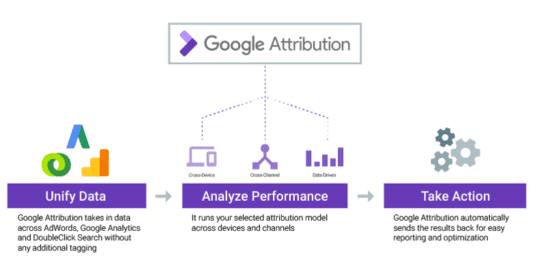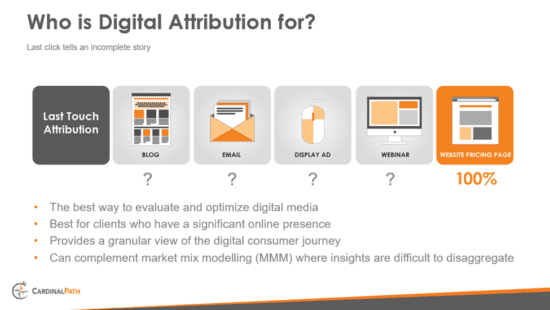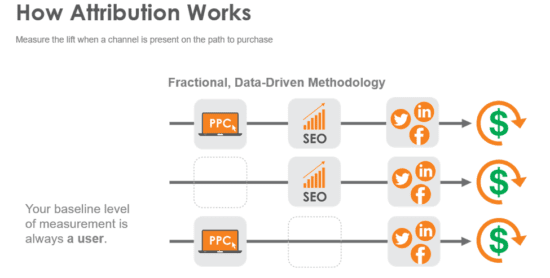Yesterday, Google announced the launch of Google Attribution, a new solution designed to move marketers beyond last-click attribution. Google’s approach is to assign a weighted value to all the various touchpoints along a customer journey to help you understand what role each touchpoint plays in driving conversions.
“Google Attribution is a new tool that helps you to measure the impact of each of your marketing touchpoints, across multiple channels, and across multiple devices – and makes it super easy to take action,” said Google’s Bill Kee, Group Product Manager, Attribution, from onstage at the Google Marketing Next conference in San Francisco. (View the major announcements from Google Next in this video – Bill Kee’s session on Google Attribution is at 33:40)
By making use of data you already have within AdWords, Google Analytics, and DoubleClick Search, Google Attribution delivers a unified view of the customer’s digital path to purchase, and brings together the existing attribution features in these tools. And – it’s free, with a release set for later this year.
For smaller organizations that primarily advertise through AdWords or Doubleclick Search, this should be a big kick-start to help them gain a deeper understanding of how their marketing efforts contribute to overall value.

The enterprise version – Attribution 360 – is designed for enterprise advertisers with more robust data integration and modeling requirements. With this paid, premium version of Google Attribution, marketers can also incorporate data from DoubleClick Campaign Manager to include in their attribution model.
As part of this announcement, Google says that they will be connecting users across devices. We’ll need to wait and see how this shapes up, but if Google automatically connects users across their devices (anonymously) to gain a real view into attribution at the unique user level, these platforms should prove extremely powerful for marketers and will certainly make it much harder for the paid platforms to compete in the marketplace, just like they did when they released Google Analytics for free.

To some degree, digital attribution is for everyone that runs digital advertising. If you have a digital marketing budget and are running campaigns to acquire customers or leads, then you should be measuring the performance of those efforts and gaining an understanding of what’s working and what’s not, ie: attributing conversions to the channels that made them happen. Even with the existing tools in digital analytics platforms, organizations have the ability to move beyond last click already. Google Analytics has a built in manual Attribution Modeling tool that allows you to compare various models.
Google Attribution will just make all of this easier, by exposing their data driven attribution modeling platform to everyone and taking the guesswork out of what model to use.
Game Theory
At a high level, attribution compares converting and non-converting paths to understand the overall lift when a channel is present, and when it isn’t present. This requires the ability to track an individual user as they engage with all of your online marketing channels. The underlying methodology is based on game theory.

So now that the technology is being made available, the question is,“Are marketers ready to make the shift from last-click mentality to this virtual black box that tells you how to shift your spend?,” says Dave Eckman, CTO, Cardinal Path.
The answer will depend less on technology than marketers’ willingness to adapt to a new reality for measuring the impact of their digital efforts. When technology is introduced, other areas, such as KPIs, need to evolve as well.
From the floor of the Google Next event, Cardinal Path’s Director of Digital Marketing, Shawn Gannon, spoke with several clients to gauge their reaction to the announcement. “One of the pain points people keep on pointing out is the fact that they have trouble getting alignment from agencies and internal stakeholders, which prevents them from moving past last-click,” he says. “You need data from various sources, and if there’s no consistent way to access this data, last-click is often the easiest way to go.” Still, it’s a positive development for a marketing tech stack that has been progressively building out its capabilities.
“It’s exciting,” says Eckman, “largely due to the fact that marketers will be able to utilize machine-learning capabilities to understand which efforts are having an impact on conversions. Even smaller advertisers can get a deeper view into how various digital channels are playing a role in the path to purchase.”
He goes on to say there is a caveat: While Google is working to simplify attribution modeling, and help organizations realize a more holistic attribution solution. “We’ve seen that even with the right tools, it can be a challenge. For organizations that advertise beyond the Google stack, they will need to ensure that they have governance around their campaign tagging efforts to ensure that all touchpoints driving users to a property are being captured. We still see organizations struggling to get all of their campaigns properly tracked, and an attribution solution is only as good as the data fed into it.”
So, what does this all mean for existing Google Analytics users? Well, until (free) Google Attribution is available later this year, we’ll be working closely with Google and our enterprise clients to ensure we’re ready to activate the latest features of the Google Analytics 360 Suite, including (paid) Attribution 360.
Cardinal Path is hosting a webinar series, delivered alongside Google Product Managers, to help marketers better understand the value of the Google Analytics 360 Suite. Attribution 360 will be covered on July 27th. Register for one session or the entire series.
And check out Danika Law’s “attribution pep-talk”, to help with your attribution preparedness as you consider options.
Dave Eckman also says the announcement may have the effect of jumpstarting competition to make attribution solutions more accessible for marketers. “It’s still early days, but there’s a lot of interest from clients around these solutions. We’re looking forward to working with Google Attribution and Attribution 360 and other best-in-class solutions to continue to move organizations beyond last-click.”


















